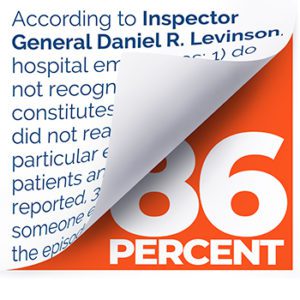
A just-released study by the U.S. Department of Health and Human Services concludes that 86% of all hospital bedside mistakes go unreported. This is a stunning finding that should have all Americans screaming for national patient safety reform.
As someone who might someday have to go to a hospital, or have a loved one go to a hospital (isn’t this most of us?), I’m angry that hospital safety is even an issue. Why is there no national movement to demand accountability from healthcare? Where is my doctor on this? Where is yours?
Numbers are Alarming
The healthcare industry has a dismal track record of responding to searing evidence that patient safety is a problem. Ten years ago the National Academy of Sciences issued a landmark report on patient safety that put the preventable death toll in hospitals at 98,000 annually.
More recent information, including a study in Massachusetts earlier this month and data out of Florida this summer, shows little progress by hospitals in reducing this alarming death toll.
The new study titled “Hospital Incident Reporting Systems Do Not Capture Most Patient Harm,” by the Office of the Inspector General at HHS, investigated how medical mistakes involving Medicare recipients are identified and reported by hospitals. These events included medication errors, severe bedsores, hospital-acquired infections, complications from overuse of painkillers and excessive bleeding linked to improper use of blood thinners.
HHS’s investigation found that only 1 in 7 medical errors are currently reported!
This is a huge number, considering that the HHS previously reported that 130,000 Medicare beneficiaries experience adverse events in hospitals each month.
Reports of Errors Rarely Lead to Policy Changes
What’s even worse, the study notes that even when hospitals identify and report preventable mistakes, they rarely change their policies to keep them from happening again. How can this be?
It’s not because employees are afraid to report mistakes, according to Inspector General Daniel R. Levinson in an interview with the New York Times. It’s that hospital employees: 1) do not recognize “what constitutes patient harm,” 2) did not realize that particular events harmed patients and should be reported, 3) assumed someone else would report the episode, 4) thought it was so common that it did not need to be reported, or 5) suspected that the events were isolated incidents unlikely to recur.
Because so many incidents are falling through reporting cracks, so to speak, hospital administrators don’t see the frequency or patterns of mistakes, and so don’t initiate policies or practices that can help prevent them.
Hospital Response Can Save Lives
The report recommends hospitals improve their reporting processes. This includes that the healthcare industry as a whole standardize what is meant by “adverse event” and then educate all staff, along with medical and nursing school students, about preventable errors and how they should be reported.
This is not a difficult fix. It doesn’t require high-priced equipment or, heaven forbid, Congressional compromise. But it will require some urging by consumers so that the healthcare industry realizes we are aware that hospital patient safety is a problem.
I make it a point to bring up medical error statistics in my conversations with people as soon as the topics of high medical costs and health insurance rates come up. I’m hoping my ire “trickles up” to anybody who can make a difference. And I vote for lawmakers who support patient safety reform. I urge you to join me.
RELATED POSTS
MRSA Infection: When Can Medical Professionals be Held Liable?
